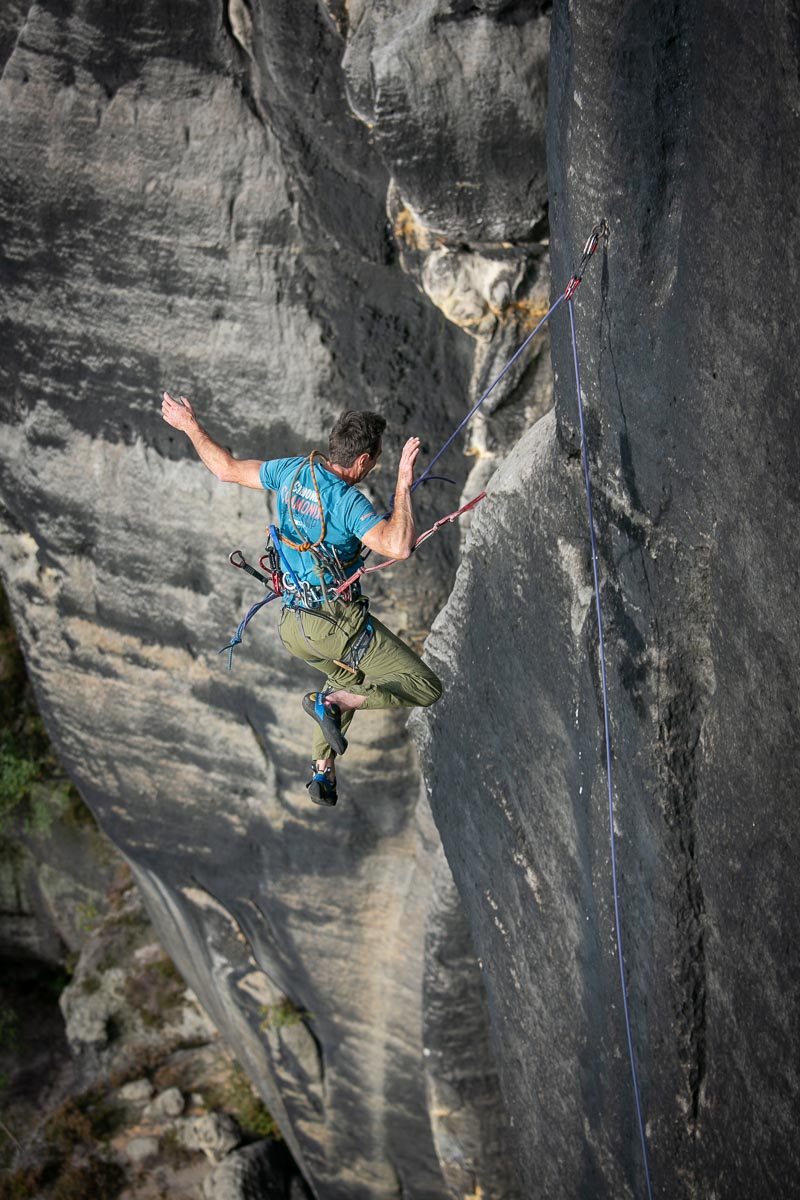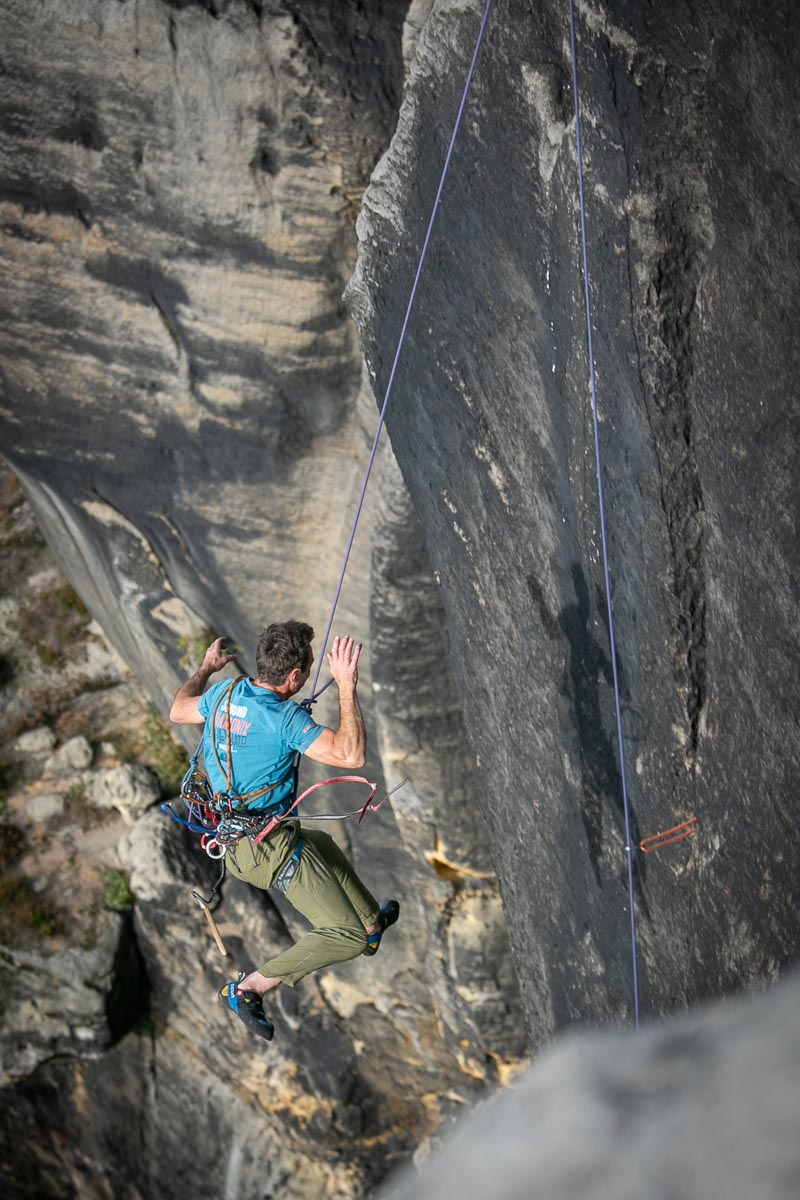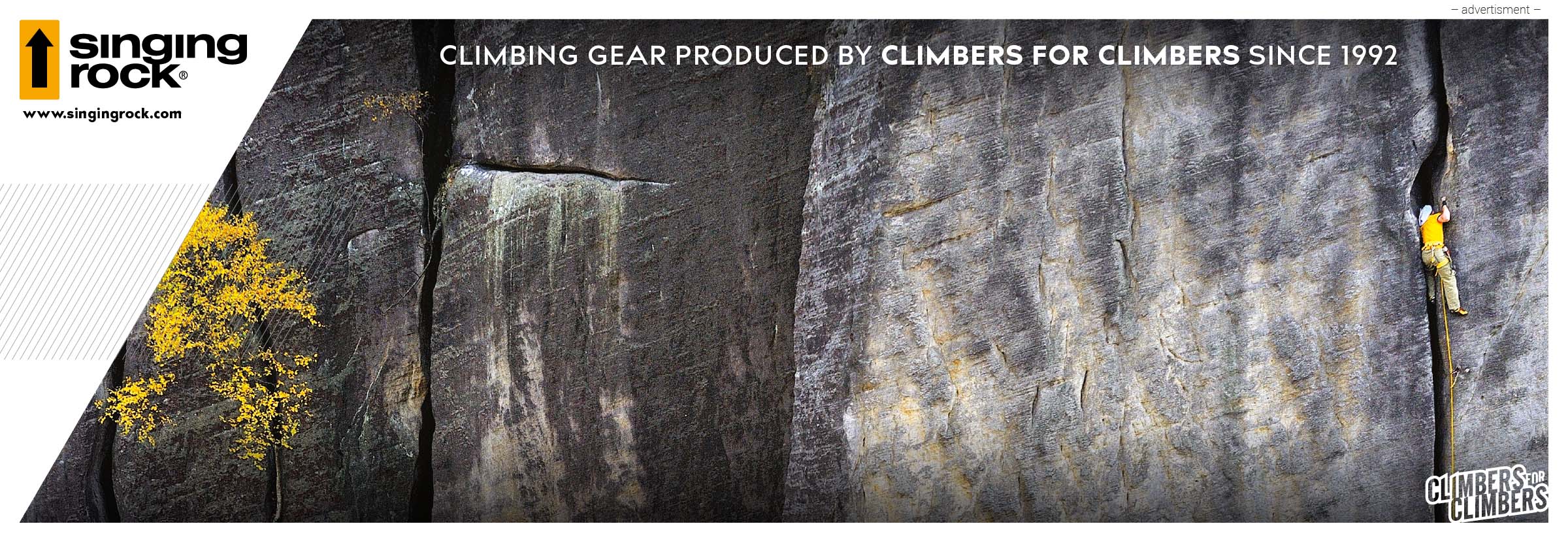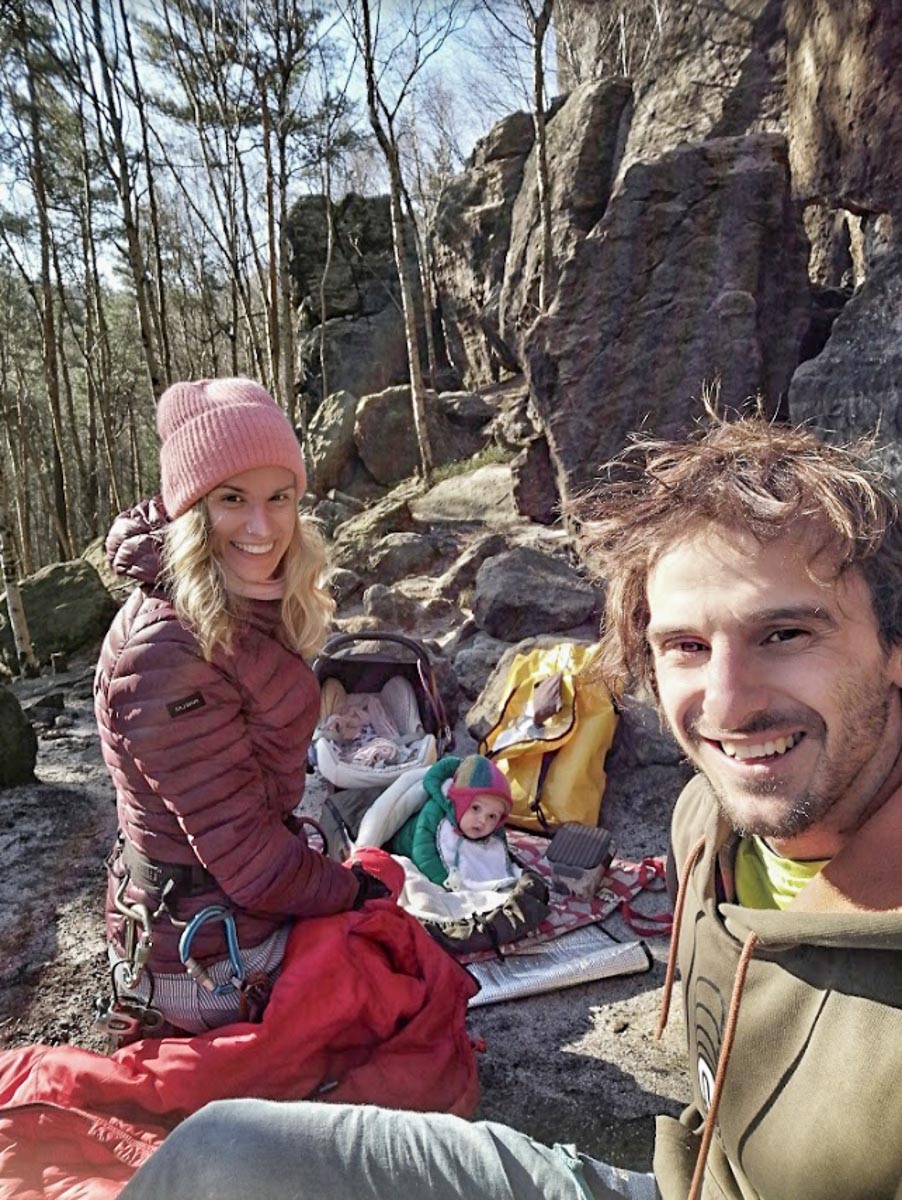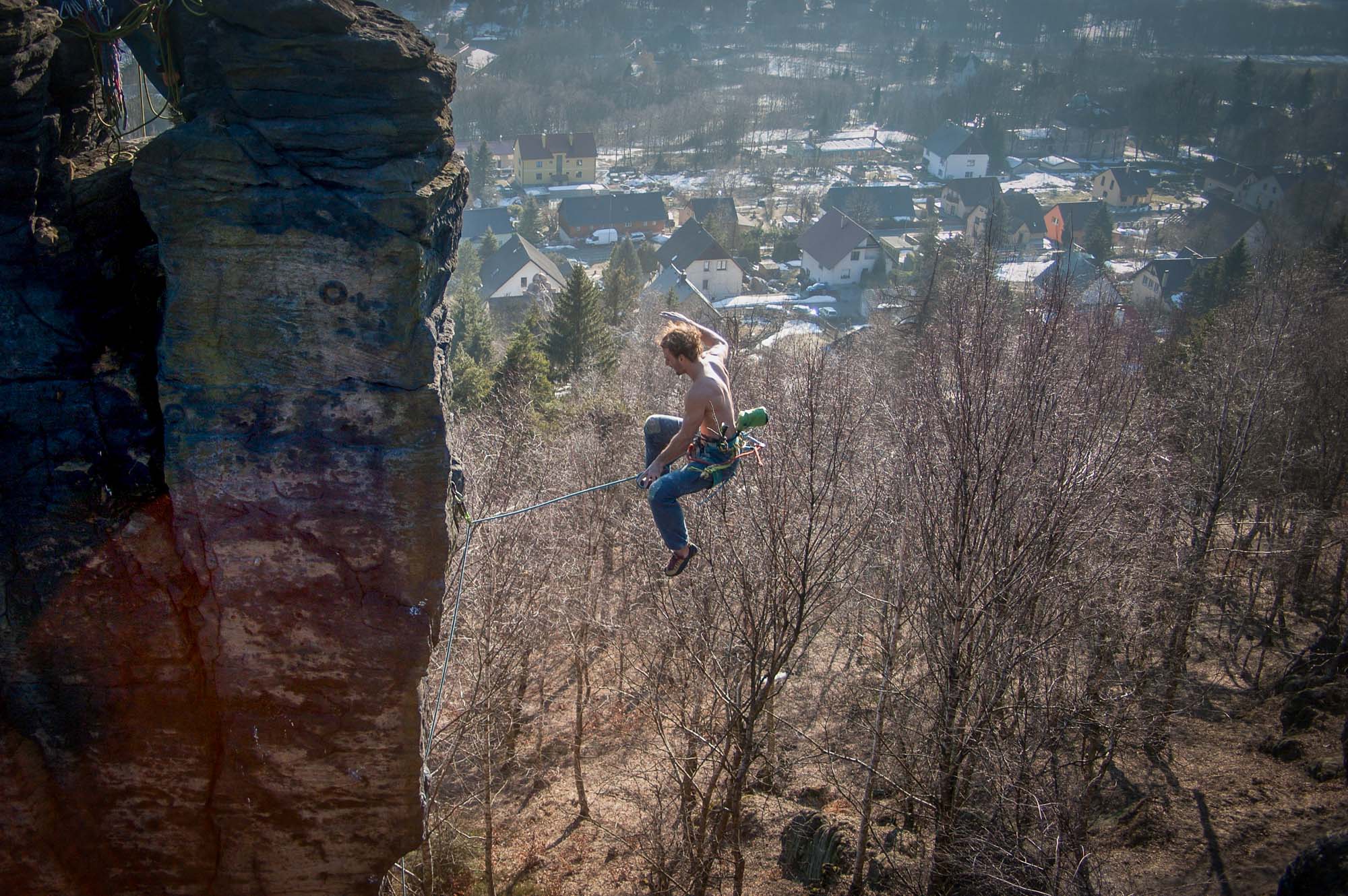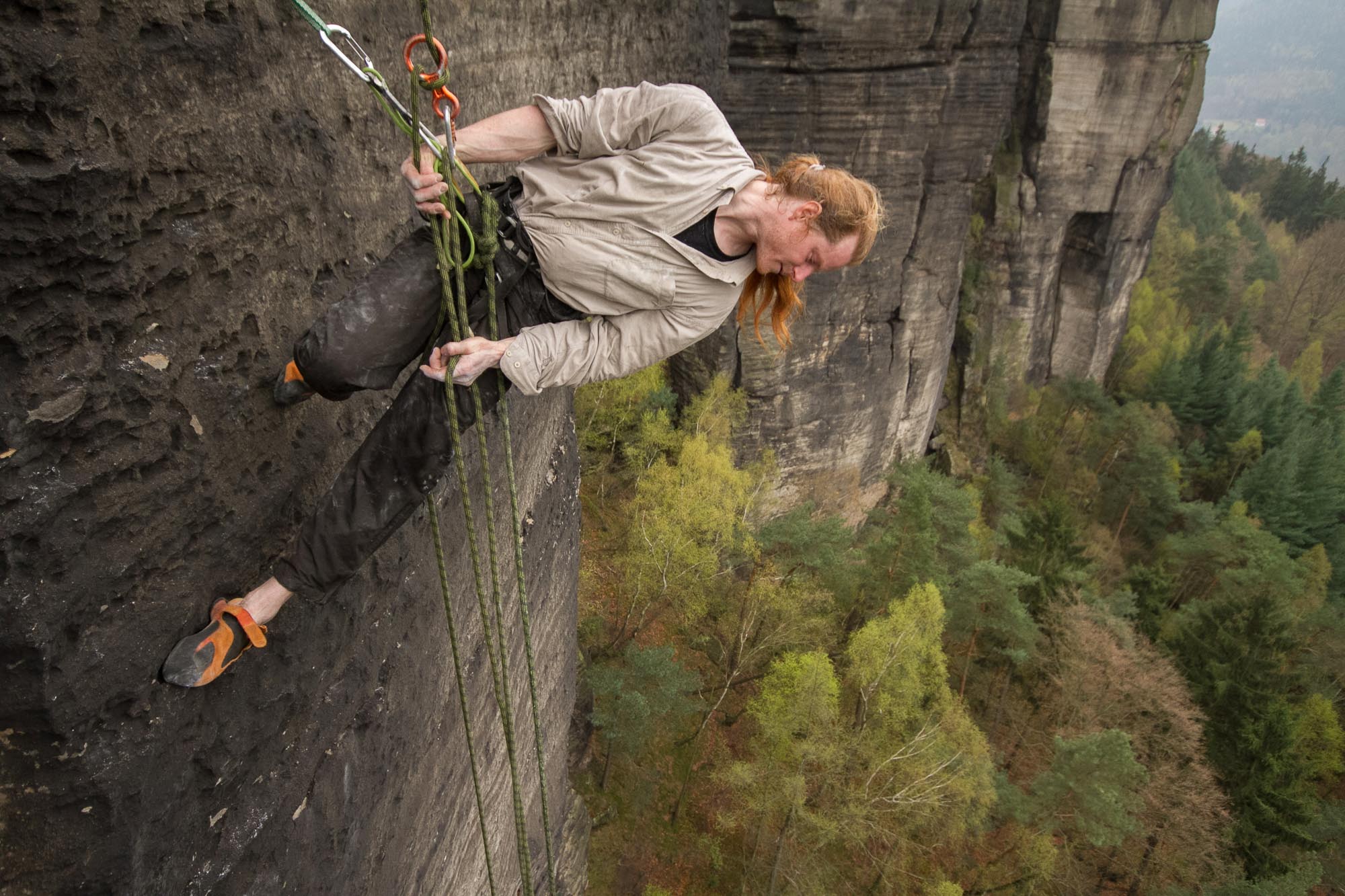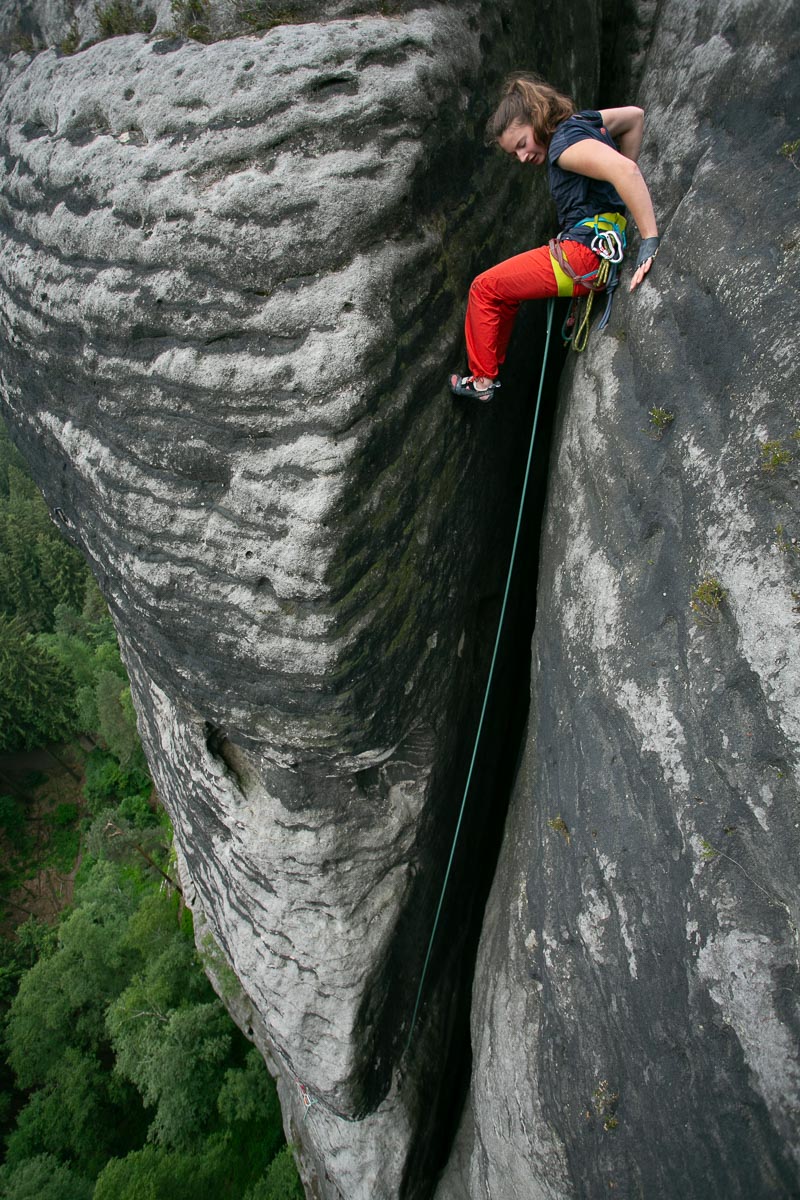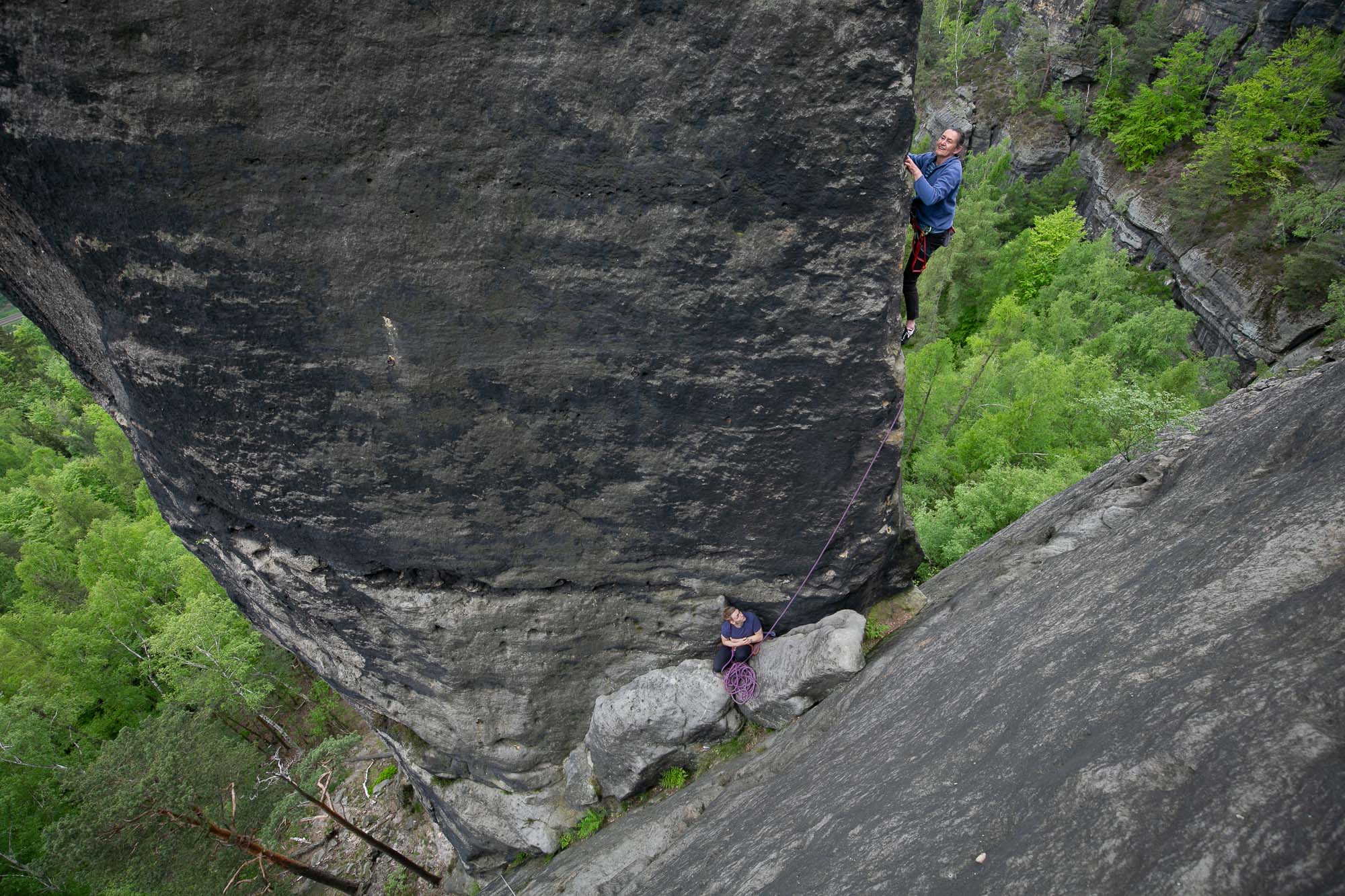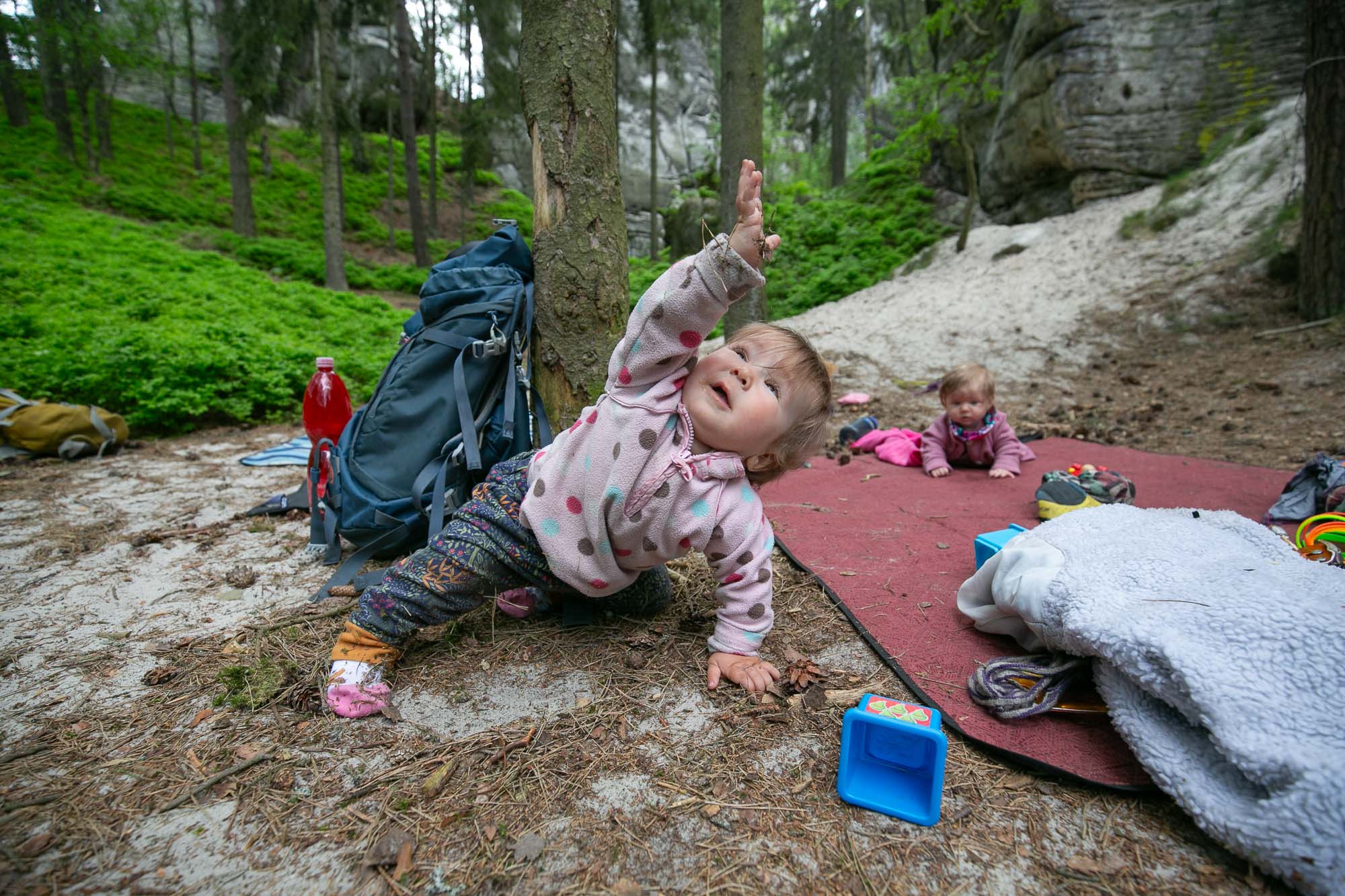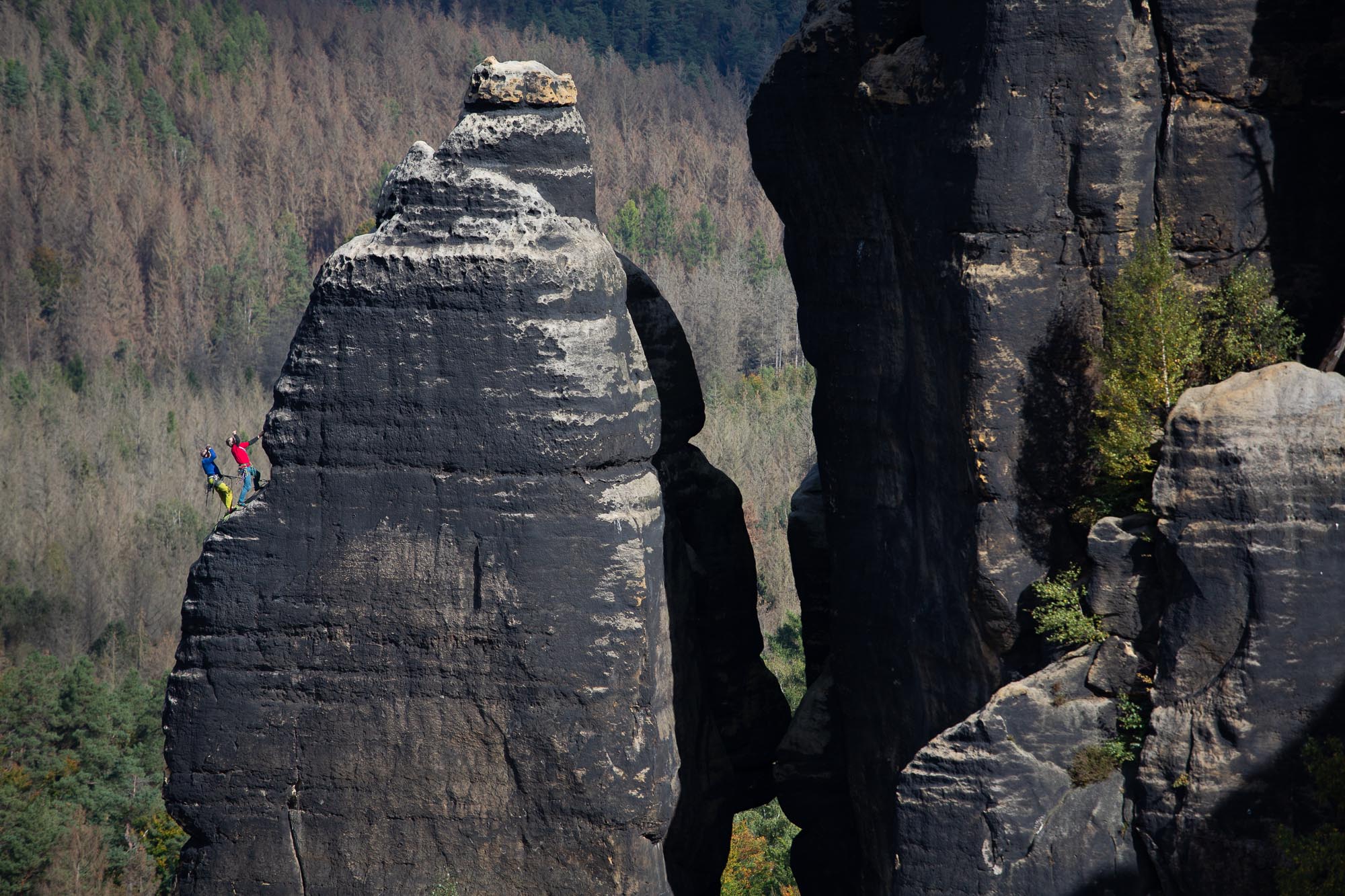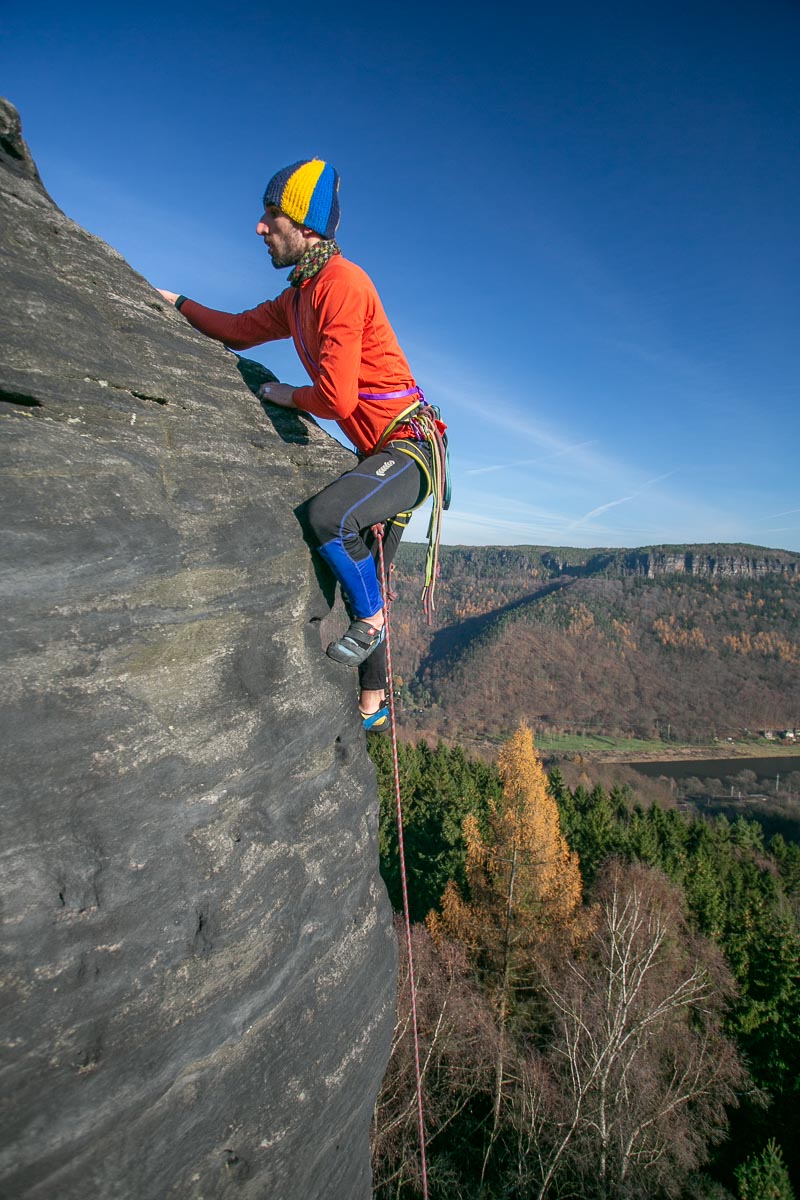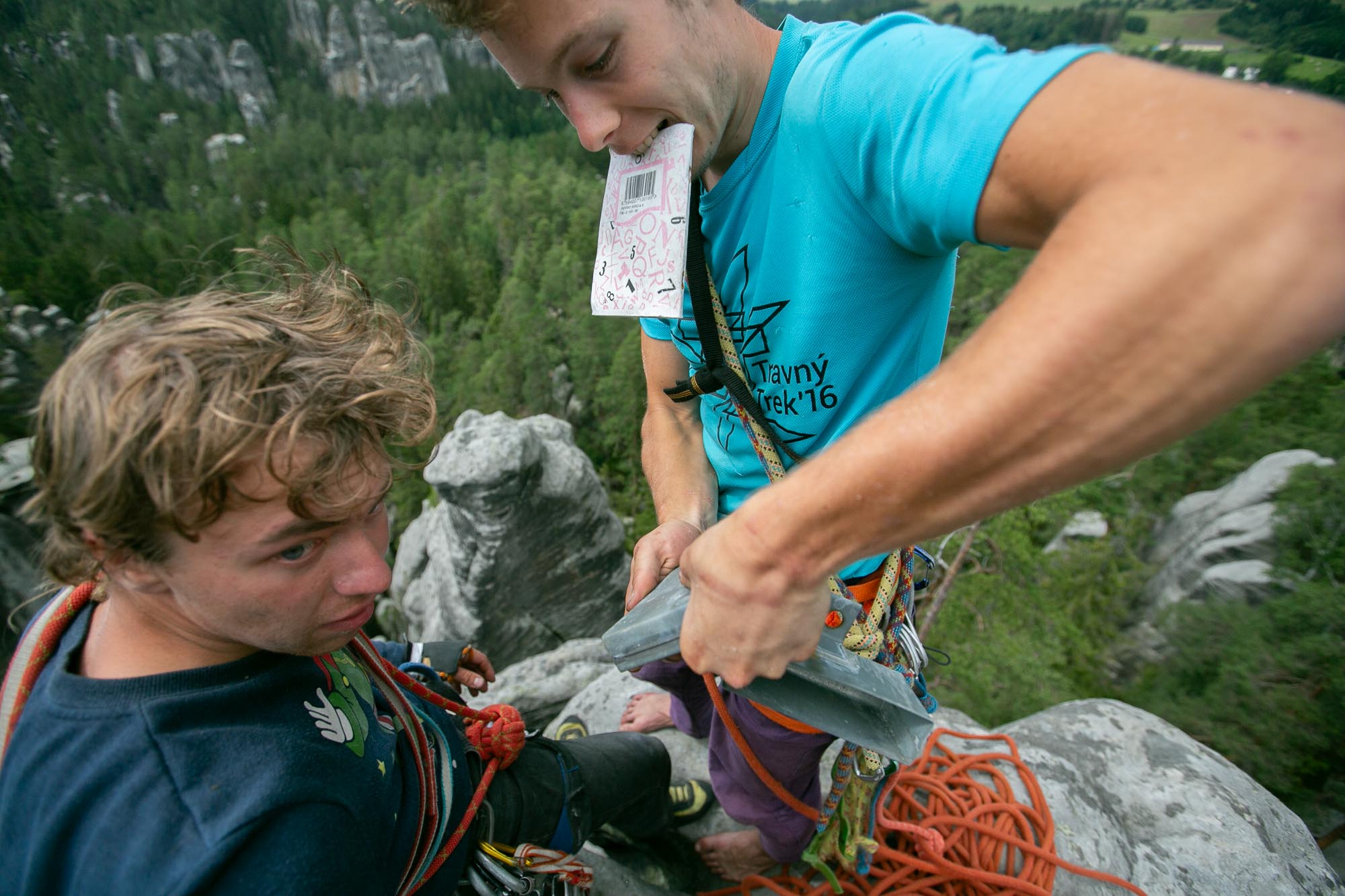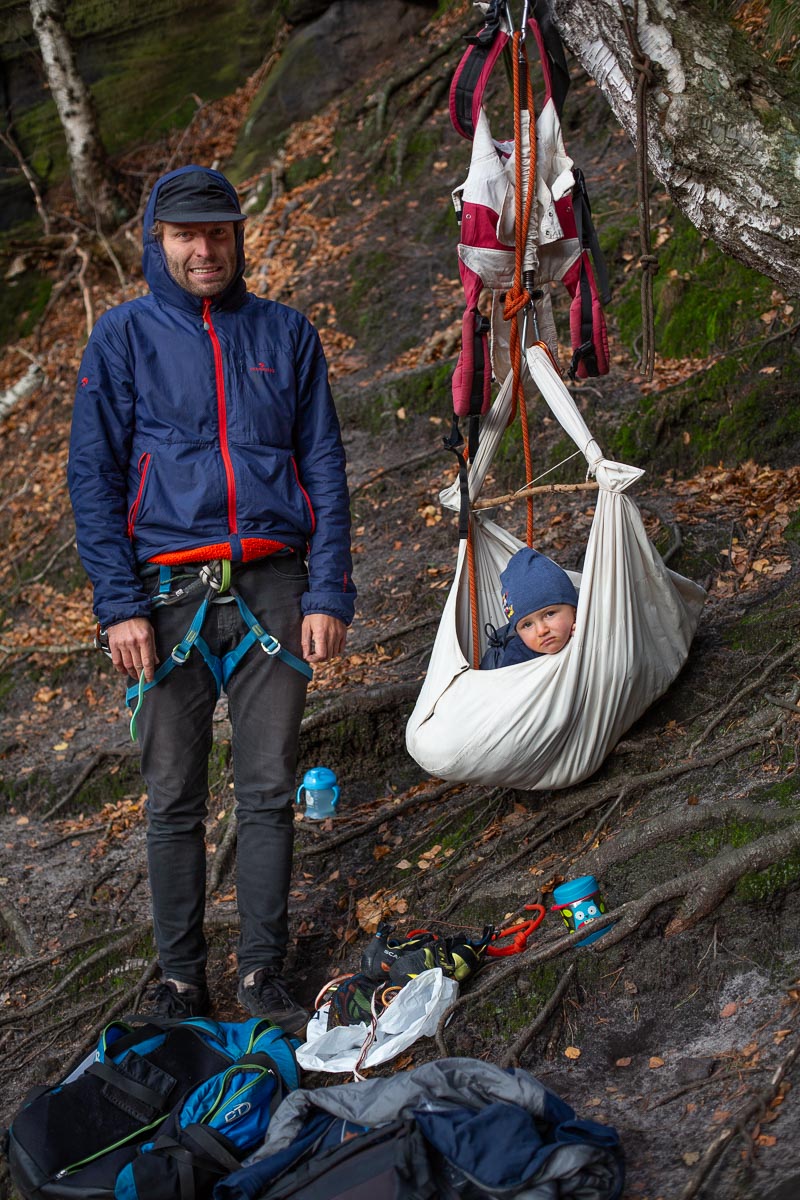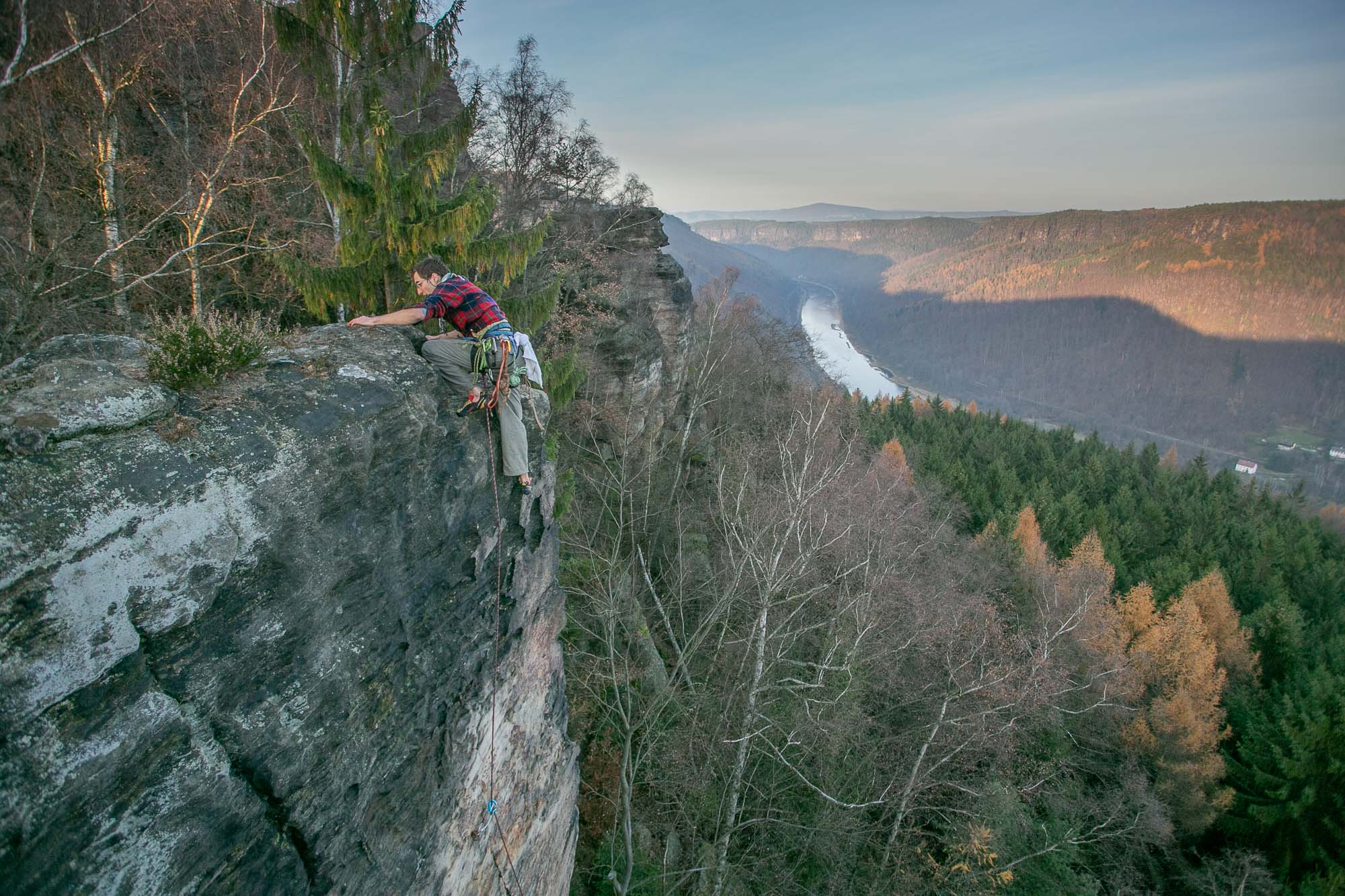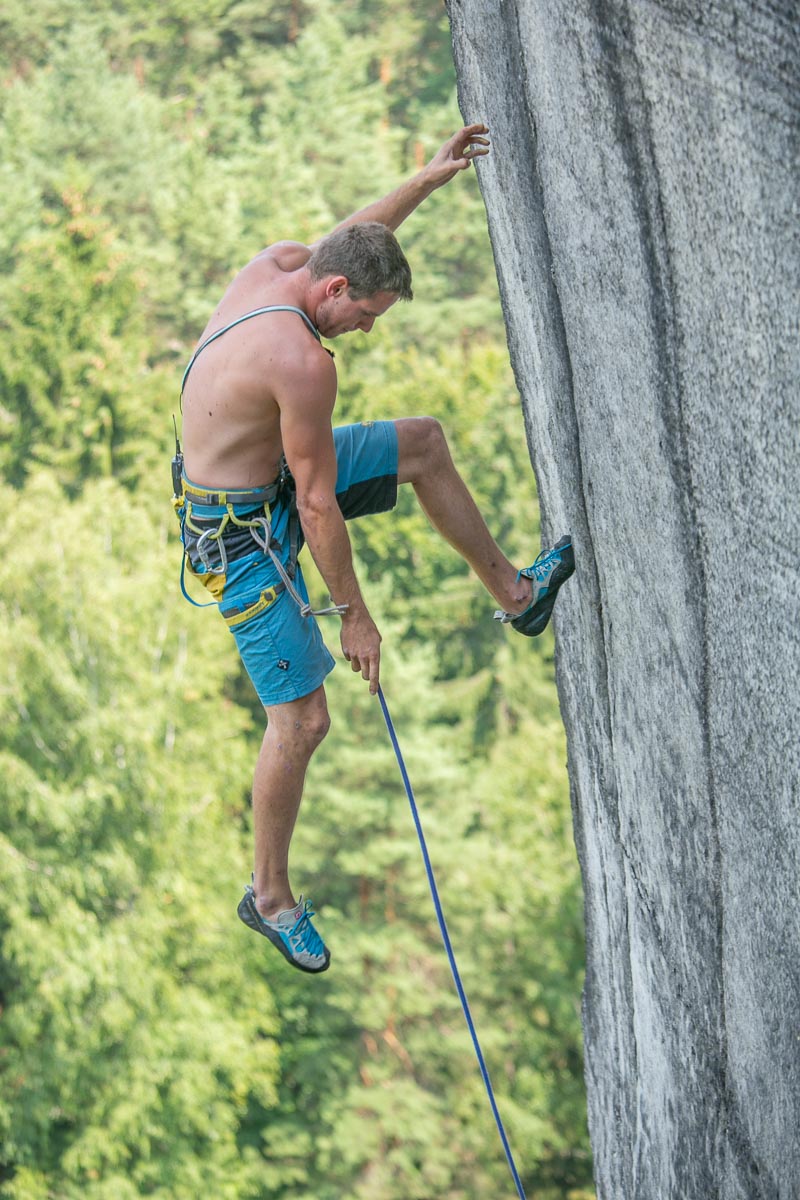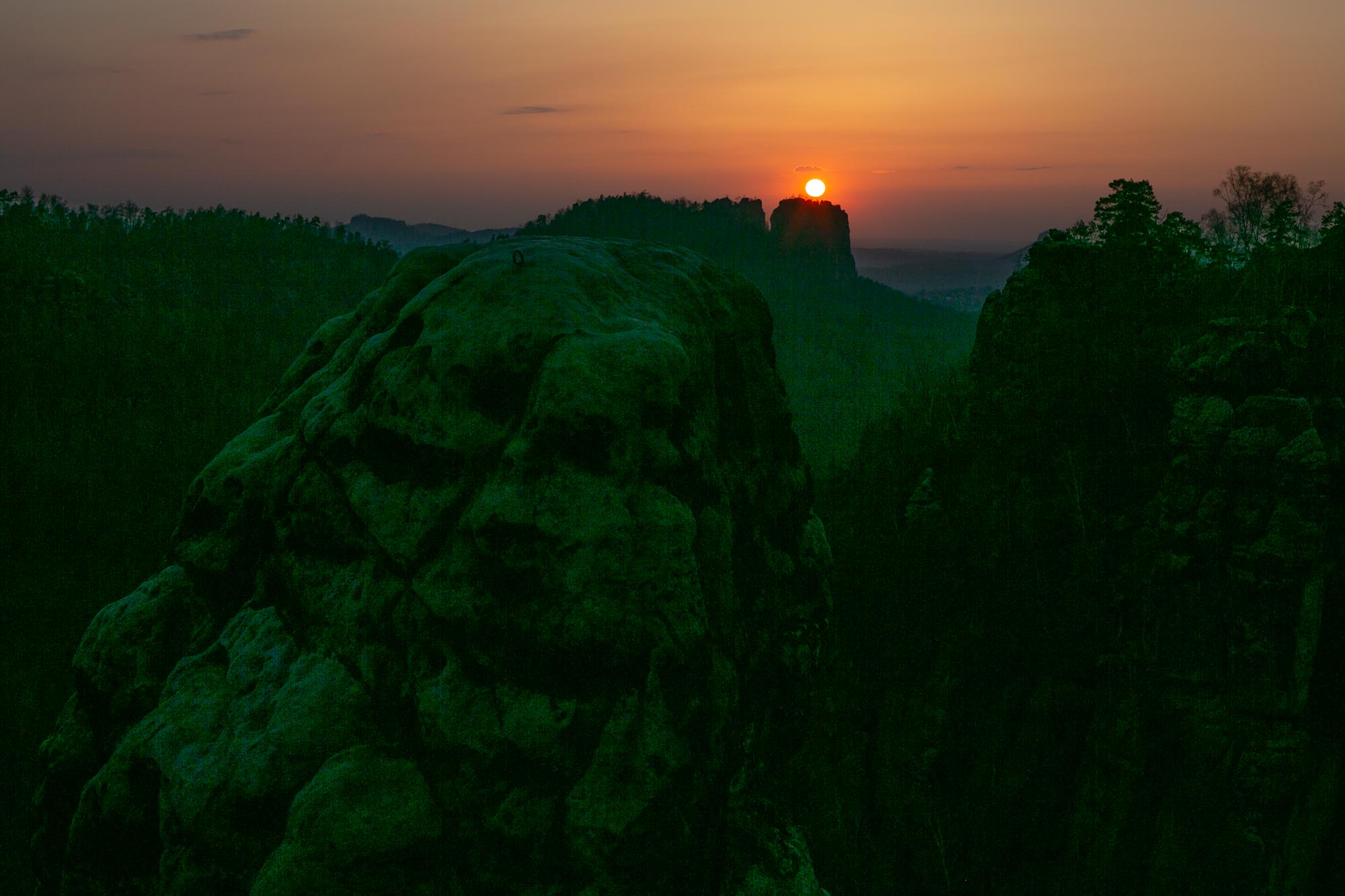RING JUMPING
The climb to the top is not the end of the journey. There’s one more challenge in this game — getting back to the last ring. The good news: if you’re determined, you’ll always win. Even if you come down, even if you jump. Gravity is with you.
CLIMB OR FLY
Pepino Nežerka Sr. used to tell this story. It took place on the Kořenáč tower in Ostrov, Elbe Sandstones. About twelve years old Lucka Hrozová just climbed the Orange Express VIIIa on the sharp end and found herself at the flat top. According to the story, she didn’t know exactly what to do. Someone shouted at her from below, “Jump down!” To everyone’s amazement, it only took a few seconds and the young climber was flying through the air into the last ring… “I guess my dad drove me there, he was a bit of a nutter,” Lucka vaguely recalls years later.
However, the significance of the story lies in its timelessness — at the time when everyone was still belaying on the towers from above, the underage Lucka already knew where the trend was going. Now it’s 2024, time is accelerating, time to climb is running out, everyone wants everything now, and this has led to the emergence of a new discipline: ring jumping.
What is it? It’s simple enough — a return to the last ring of the journey. If you want to count the climb as an “R”, you just climb to the top of the tower so that you can sit on your butt (holding the top with your hands is not valid, see for example the Arete of Falls VIIIb on the Gilotina in Adrspach, note by the author) and then commit to moving downwards.
Practically speaking, you have more or less two basic tactical options to get back to the last ring. Either you take advantage of your physical superiority and descend the section without falling, or you solve it with morale and commit to a jump… Either way is considered a successful “send” in this discipline. The goal is the last ring.
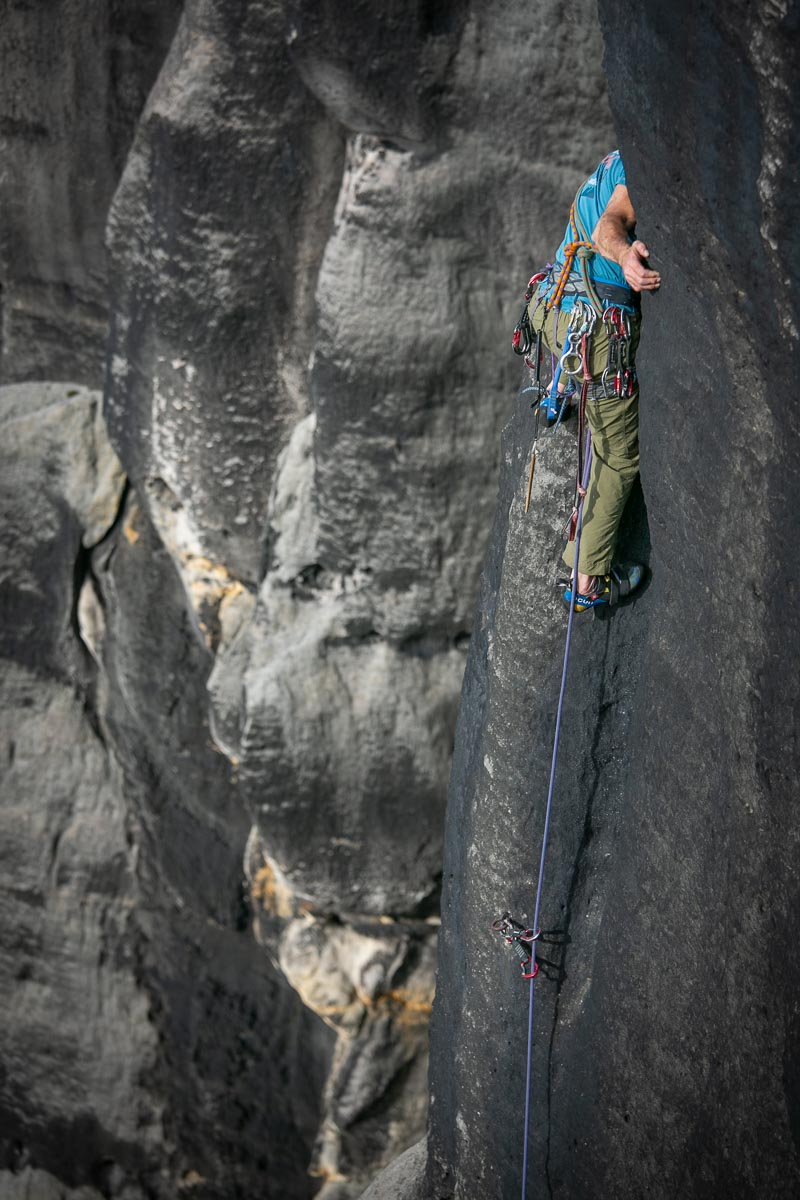
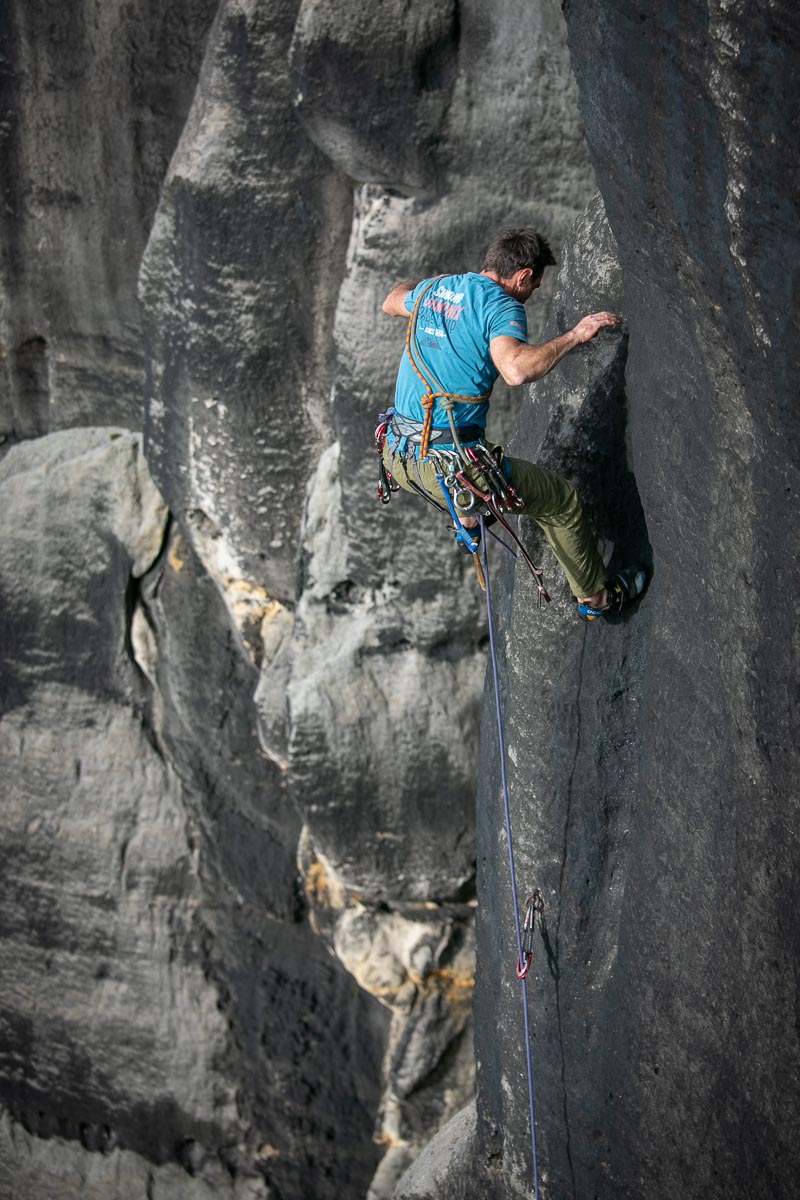
WHY RING JUMPING?
This new philosophy combines all the advantages. You don’t have to waste your time with sandstne climbing formalities — nobody reads the top books anymore anyway. Online diaries are important. You don’t have to wait for your mate to climb the tower — it’s windy up there and you can get cold. Pulling the rope and rappelling to the other side of the tower? That also eats up valuable time. It takes a few seconds to make a good whipper to the last one. (We recommend an experienced belayer for ring jumping, ed.)
In one day of rock climbing, you’ll gain a lot more meters and climb more. The down-climbing part can often be the most moral and tricky section of the whole climb. So don’t be surprised if someone asks you, “Are you only doing it for RP? You were afraid to send it as an R, weren’t you?“
Another advantage: if you’re a methodical hoof and can’t move the belay station to the edge of the tower (photo), you’d better jump down to the last one. That way you won’t be scraping rock at the top, you won’t endanger the second climber with a bad belay, and you’ll set up his top rope while still in the vertical.
If you’re a seasoned climber and are bored with the same old summit climbing, rope friendships and so on, ring jumping brings you a breath of fresh air and a new discipline to get better at. Just like climbing up, it has different levels of difficulty: in ring jumping there are four basic ones and they are written with the letter R (like Ring, Return or Roulette, ed.).
“Are you only doing it for RP? You were afraid to send it as an R, weren’t you?”
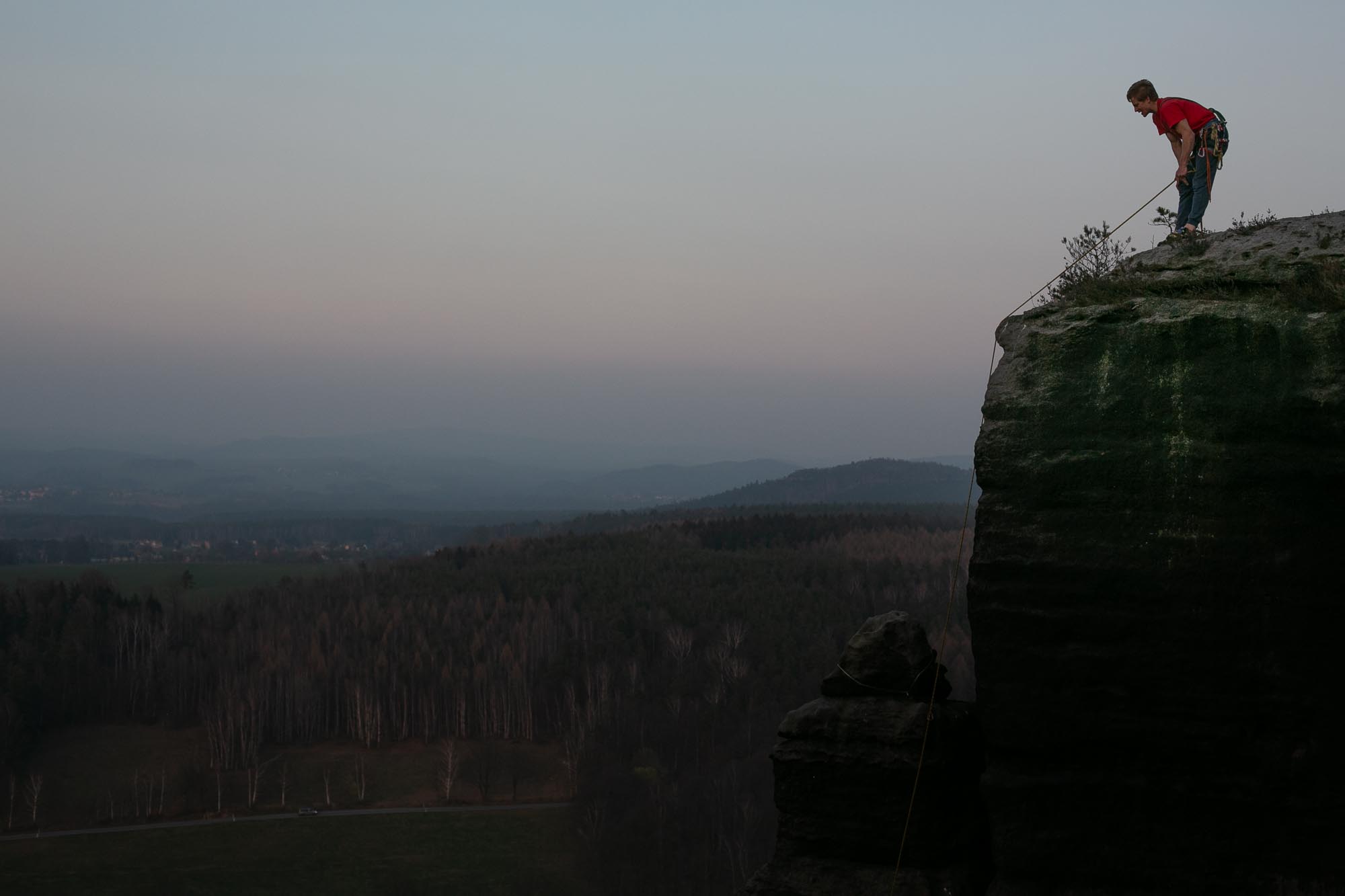
R0
Modern routes to the massifs — you use a mailon and let yourself be lowered.
R1
Easy descent a few meters to the last ring, clear.
R2
Easy 15m downclimb, taking out slings, less risk.
R3
Uncertain moves back to a ring that is already out of your sight, often sideways, risk of a serious fall if you slip.
R4
Extreme cases, ring very deep underfoot, physically demanding descent with possible risk of grounding.
RING JUMPING AS A WAY OF LIVE
One of the passionate followers of the new climbing philosophy is Zdenda Faltys. He knows well how precious is the time for climbing, and that is why he mostly uses this strategy in his home crag Tisá. When he asks, “How hard is that?” he often doesn’t mean the traditional climbing grade, but the new “R” grade. It’s understandable — if you have kids and only go to the crags after work, this becomes the most important grading.
What has changed for you with the discovery of ring jumping?
It brought more efficiency to my climbing. It also put an end to arguments with my friends about who was going to lead. This way, everyone can lead and no one is upset that they have to climb on top rope after someone else. It also brought an end to tangling ropes at the top of the rock, an end to lengthy rappelling preparations, an end to going around towers in climbing shoes… Instead of the rappelling process, you get to catch the next route.
What did it bring to your partner life?
Yeah, just the benefits — you don’t have to follow your girl around in a super hard routes. She’s gonna lead some sandstone Xa (7c fr.), jump in the ring, and then lead some sevens (5c+ fr.) for your comfort. She sets you a top rope and everyone’s happy. Especially when the kids are down there.
How do you choose your ring jumping routes?
During normal climbing, you often look to see which route has the lowest ring. Here, paradoxically, it’s the other way around — you look for the lines that have the last ring as high as possible. A ring high means an easier “R”.
Well, yeah, but when you get into ring jumping a bit more and want to take away some valuable “sends”, you want to keep the last ring low…
That’s true. I take it as a challenge sometimes, too.
So what’s your hardest R?
I can think of “Linear Vertical” VIIIc on the Big Ostrov Wall, Elbe Sandstones. I’d give it an R3 grade — from the top you must downclimb a long overhanging wall… Or jump. I was scared, so I chose the first option and it worked out (laughs).
WELCOME TO THE RING
Going down is not always a success. Sometimes you just get sick to your stomach when you look down, shit it out and stay up. It’s a bit awkward when you’re belayed by someone who doesn’t have the skills to second your route… But don’t worry, we’ve got a solution for you here too: You pull the rope, rappel the normal rappel route and leave the slings and quickdraws in the route… Then the next day, you’re gonna drop it off to your buddies on FLASH with the words: “Make sure you climb this one — that’s a beautiful route!”
As you can see from the article, ring jumping has become an established whistling discipline over the last few seasons. Tower jumping is no longer a staple. Nowadays, ring jumping is in. Fancy some R scalps? We’ve got some tips for you to try.
R1
For starters, one to warm up, for example Hotel Savoy IXc (7c fr.) on the Wall in Tisá, where you finish just above the last ring. The following routes could also be R1s: Bloody Cracks VIIc on Parrot Tower in Adrspah or Valley Wall VIIIb on Hláska in Teplice. Just short and clear returns. Nothing that could be talked about at length in a pub.
R2
In the R2 difficulty level you can get a bit more climbing even after the route has been climbed. In Labak, for example, in the Body Without a Soul VIIIc (6c fr.) route in Labak, if you go all the way up to write in the book. A safe descent or flight awaits you in the popular Direkte Säbel VIIIb (6b) on the Domwächter in Saxony. The aforementioned visionary Orange Express VIIIa (6a+) would deserve the same grade. A long but easy descent to the last ring of the Kotzwand VIIa (5c) route to Falkenstein would probably also be class R2. In Teplice, then, for example, Safari VIIIb (6b) to the Crocodile Wall — the lower you go, the more difficult it gets. Whiplash VIIIb (6b) is also a nice R — climb down the slab for a bit, then jump into the air.
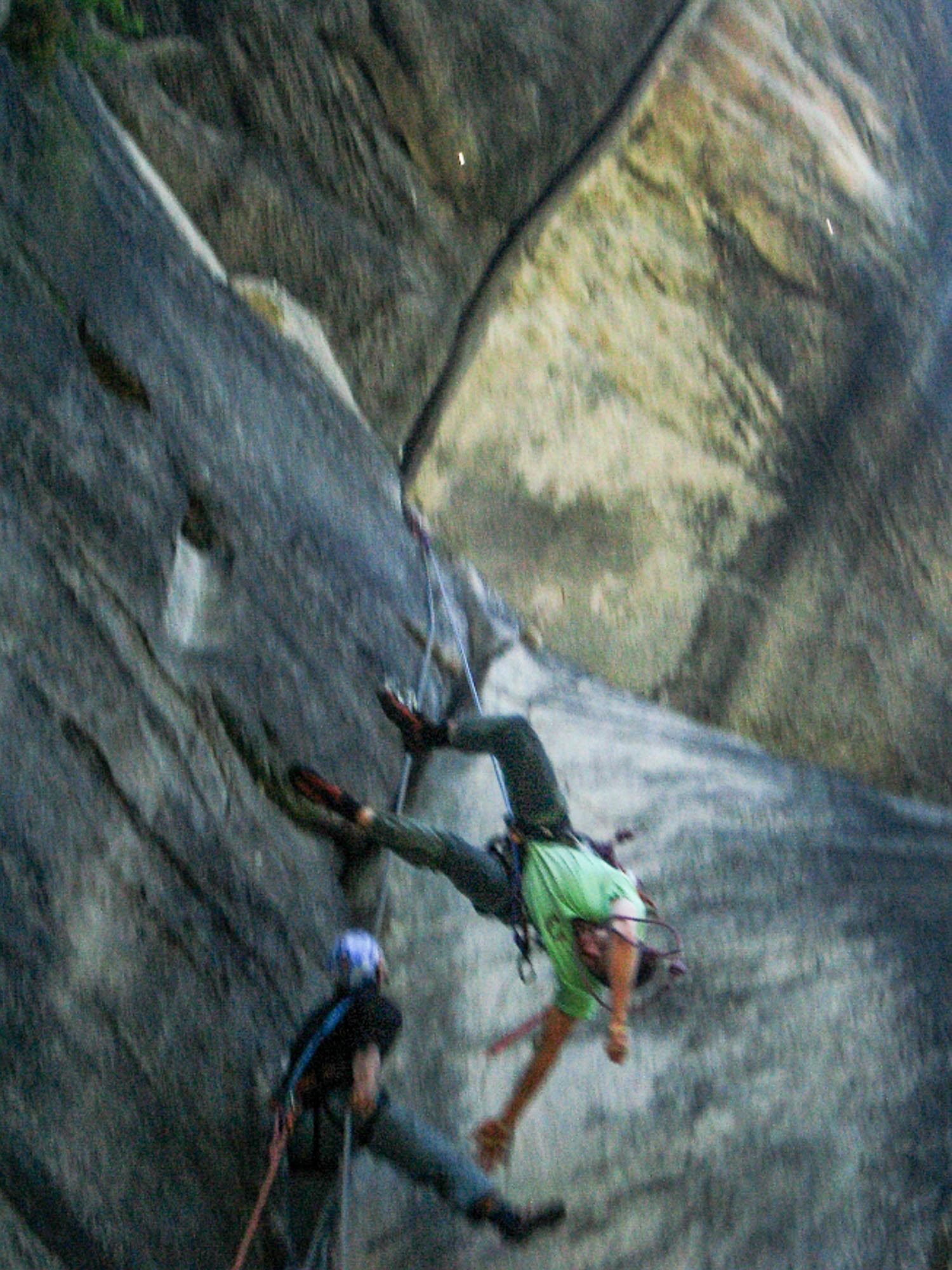
„Tower jumping is no longer a staple. Nowadays, ring jumping is in.“
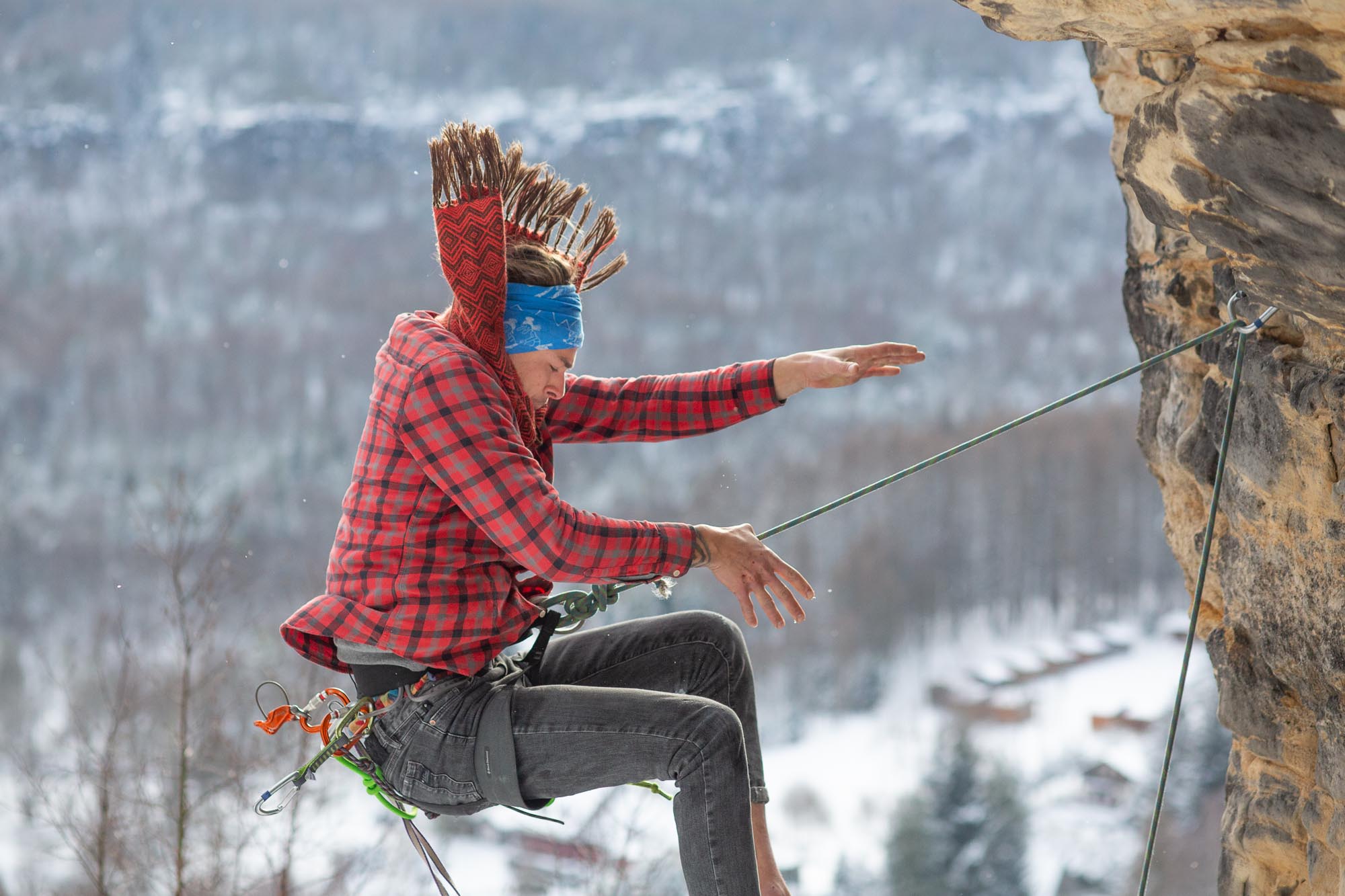
R3
The game gets noticeably tougher with threes. It’s good to have the right combination of strength and morale. And ideally also a child under the rocks who already wants to go home, and motivates with his crying to speed up the process… What threes do we recommend? The Parrot’s Crack VIIc (6a+) on the Parrot hardly anyone wants to return to the ring… Occasionally, someone involuntarily flies to it before reaching the top. But of course, this does not count as an “R climb”. You were not sitting on the top.
Kvedlovačka VIIb (6a) on Prince? Many people could probably do it, but to turn around at the top of the pine tree and start climbing down an admittedly easier hand-jam, but with the prospect of a possible ground shot from 20m, takes determination. One wouldn’t want to back out of the VIIIb (6b) cracks on the Bottles either. The same goes for Fly’s Route VIIIa on Chrámovky Walls. “There you are in danger of a 40-metre flight, that you would freeze on the way,” evaluates Tatus Žwak. However, if you’re in a big hurry to get to a business meeting, don’t place slings above the last ring, jump out of the forest and you’ll be down in seconds.
Vítek Lachman has a tip for the sporty ones: “Los Alamos Xa (7c) on the Dvorská Tower in Ádr… No one wants to go down there. You clip the last ring and do the hardest steps about four or five meters above it. Then you climb up diagonally. Coming back from the tower would be to get above the boulder where you’d take a 10-meter fall. But it’s not dangerous. That could be an R3. A few people have had that experience.” In Saxony, the “R challenge” is definitely Lineal IXa (6c) on Meurerturm. Look around the landscape, return back into the couloir, descend six metres and then find yourself in the key section of the route almost ten metres above the ring. One would fly for a long time, but nothing would probably happen to one, hence “just” R3. Similar to Direkte Westkante VIIIb (6b) on Falkenstein, where you also don’t really want to go back to the depths from the top pillar.
Zdenda Faltys has a tight tip: Laughter Route VIIa (5c) on the African Tower. “First you jump into the wooden stick, stucked in the hole, unclip and proceed to the ring, which is about one-third of the way up the wall.” Kolouch Hrudka also tried the jump to the last one, specifically on the “Normal Route” VIIb (6a+), R3 to the Cat Tower in the Czech Paradise. Somehow his feet slipped in the final unpleasant move and he thought he’d better make a planned jump: “I think I’ll go!” “No, don’t jump!” shouted his wife Jana, whom he eventually pinned to the wall with his fall and scraped the knuckles of both her hands… Kolouch ended up just above the ground. A nice R3 could also be Valley Wall VIIIb (6b) on Kapelník Tower in Hruba Skala — about 20m descent with a final boulder. Will you do it or not? It doesn’t really matter. R3 is yours.
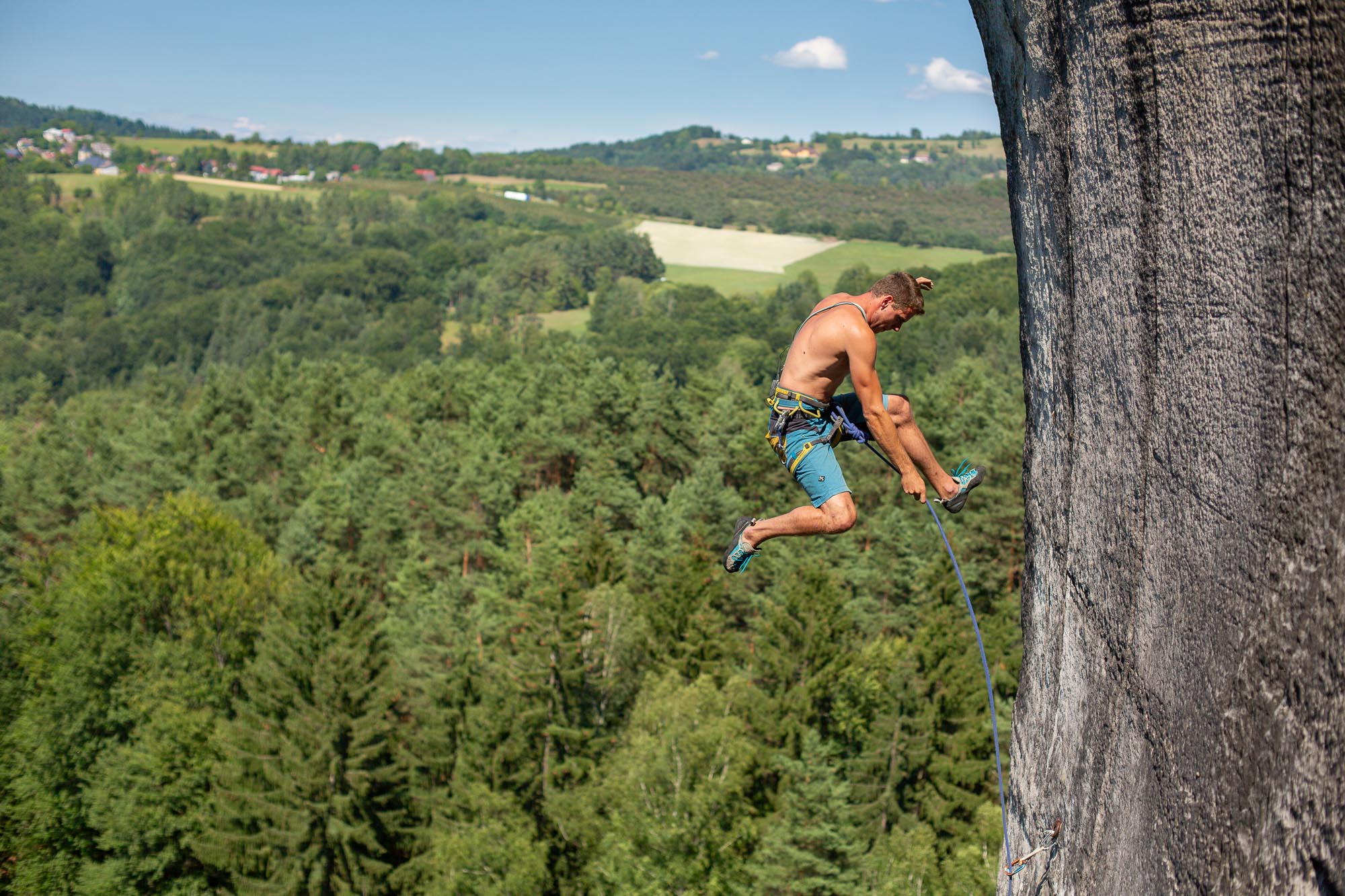
R4
High game with the rings damn low. Classy for the best ring jumpers… “I sure wouldn’t want to go down Torture! VIIIb (6b) on Karlik tower, where it’s from the ring a human pyramid from the seat and then followed by an inhumane wide climb to the top,” Tatuš chooses. Ratlik Kácha recently found out how to fly to the last ring of Letecká route VIIIb (6b) on Milenci tower, and he wasn’t quite at the top yet. Very unpleasant and nail-biting would be the climb down the Northeast Face VIIIa (6a+) to Jitřenka tower. Loose, sideways, over a small thread… You’d unclip them and blow a pendulum into the ring… The game with an even lower ring is then Valley Wall ! VIIIa to Jean Frank’s Tower — you have to come back a good chunk with a slab to get the ring to catch you again so it’s not on the ground.
Zdenda Faltys chooses the Umakart Face Edge VIIIc (6b+) on the Winkler towers as the R4 print: “You take hard moves about five metres above the ring and then you keep climbing — almost to the top. The last round is halfway up the wall — I got soft and had a second rappel rope sent up.” In Hrubá Skála, then, a candidate for the R4 grade would definitely be the Last Bell IXa route on Dragon’s Tooth. The trio of Nežerka, Rybička and Rakoncaj probably created it as a gift for future elite ring jumpers. The best jumpers know that it pays to keep your legs bent during long flights with the risk of the floor.
It’s hard to know whether to include routes where the ring is completely missing in the “R fours”. It would be fun to climb Alter Weg VIIb (6a) on Teufelsturm or Arnold’s Ringlose ! VIIIc on the Südliche Pfaffenschluchtspitze in Elbe Sandstones. However, given the name of the discipline “ring jumping” it is probably better to exclude ringless routes. They would be better suited to the “decking” discipline, which we are happy to leave to the next generation of sandstone climbers.
The eMontana editorial team wishes you a lot of soft catches!
__________

